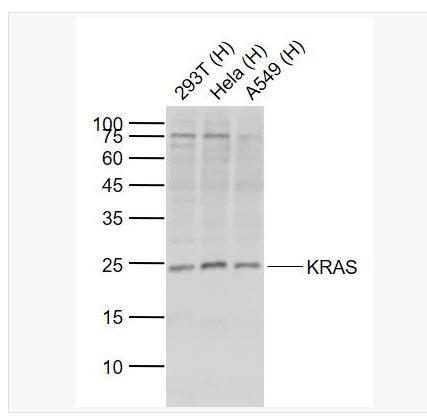Host:Rabbit
Target Protein:KRAS
IR:Immunogen Range:25-130/189
Clonality:Polyclonal
Isotype:IgG
Entrez Gene:3845
Swiss Prot:P01116
Source:KLH conjugated synthetic peptide derived from human K-ras:25-130/189
Purification:affinity purified by Protein A
Storage:0.01M TBS(pH7.4) with 1% BSA, 0.03% Proclin300 and 50% Glycerol. Shipped at 4℃. Store at -20 °C for one year. Avoid repeated freeze/thaw cycles.
Background:This gene, a Kirsten ras oncogene homolog from the mammalian ras gene family, encodes a protein that is a member of the small GTPase superfamily. A single amino acid substitution is responsible for an activating mutation. The transforming protein that results is implicated in various malignancies, including lung adenocarcinoma, mucinous adenoma, ductal carcinoma of the pancreas and colorectal carcinoma. Alternative splicing leads to variants encoding two isoforms that differ in the C-terminal region. [provided by RefSeq]
Ras, a proto-oncogene, is a small G-protein that has 3 primary isoforms (H-Ras, N-Ras, and K-Ras) that differ in there approximately 20 C-terminal amino acids. H-Ras was first discovered as a transforming product the retrovirus Harvey murine virus and K-Ras of Kirten sarcoma virus. Ras is a heavily studied target of both academic and pharmaceutical research because of its implications in various pathways and diseases as well as being mutated in a large number of human cancers. Ras is most notably the activator of the Erk/MAPK kinase pathway as activator of Raf, as well as an activator of PI3 Kinase (PI3K). In its oncogenic, mutated state, Ras is unable to hydrolyze GTP to GDP, thus staying in an active state and activating numerous pathways including the MAPK pathway through its activation of Raf, but also others as well that include PI3 Kinase and RalGDS. One path that the pharmaceutical industry has taken to control Ras and its activity is by finding what some consider its Achilles’ heel. For its activation, Ras must localize to the plasma membrane, but interestingly, it lacks a transmembrane domain. To achieve this, Ras must first undergo a post-translational modification (PTM) known as prenylation or geranylation at its C-terminal CAAX motif. For this to take place, a controlled three step process must occur. The first step in the process is the prenylation or geranylation of the C in the CAAX motif that is initiated by the covalent attachment of farnesyl groups to the cysteine that is catalyzed by the . After this modification, the and heterodimer enzymes farnesyl transferases –aaX of the motif is proteolytically removed via Rce1 (Ras Converting Enzyme 1), a membrane associated endoprotease, by a mechanism that is still not fully understood. Finally, the C-terminal prenylcysteine is now methlylated by ICMT (Isoprenylcysteine Carboxymethyl Transferase). These drugs have yet to pass clinical trials though and there is doubt that they will ever be successful in treating tumors associated with Ras activation.
Size:50ul
Concentration:1mg/ml
Applications:WB(1:500-2000)
ELISA(1:5000-10000)
IHC-P(1:100-500)
IHC-F(1:100-500)
Flow-Cyt(1ug/Tset)
IF(1:100-500)
Cross Reactive Species:Human
Mouse
Rat

本产品仅供科研使用。不能用于人和动物治疗等其它临床诊断使用!
关键字: KRAS;C-K-RAS; c-Ki-ras;RASK2;RASK1;
上海沪震实业有限公司是一家集研发、生产和销售于一体的生命科学实验室产品生物科技企业。主营产品:试剂盒,ELISA试剂盒,抗体,重组蛋白,血清,胎牛血清,细胞,原代细胞 细胞培养试剂,常用生化试剂。